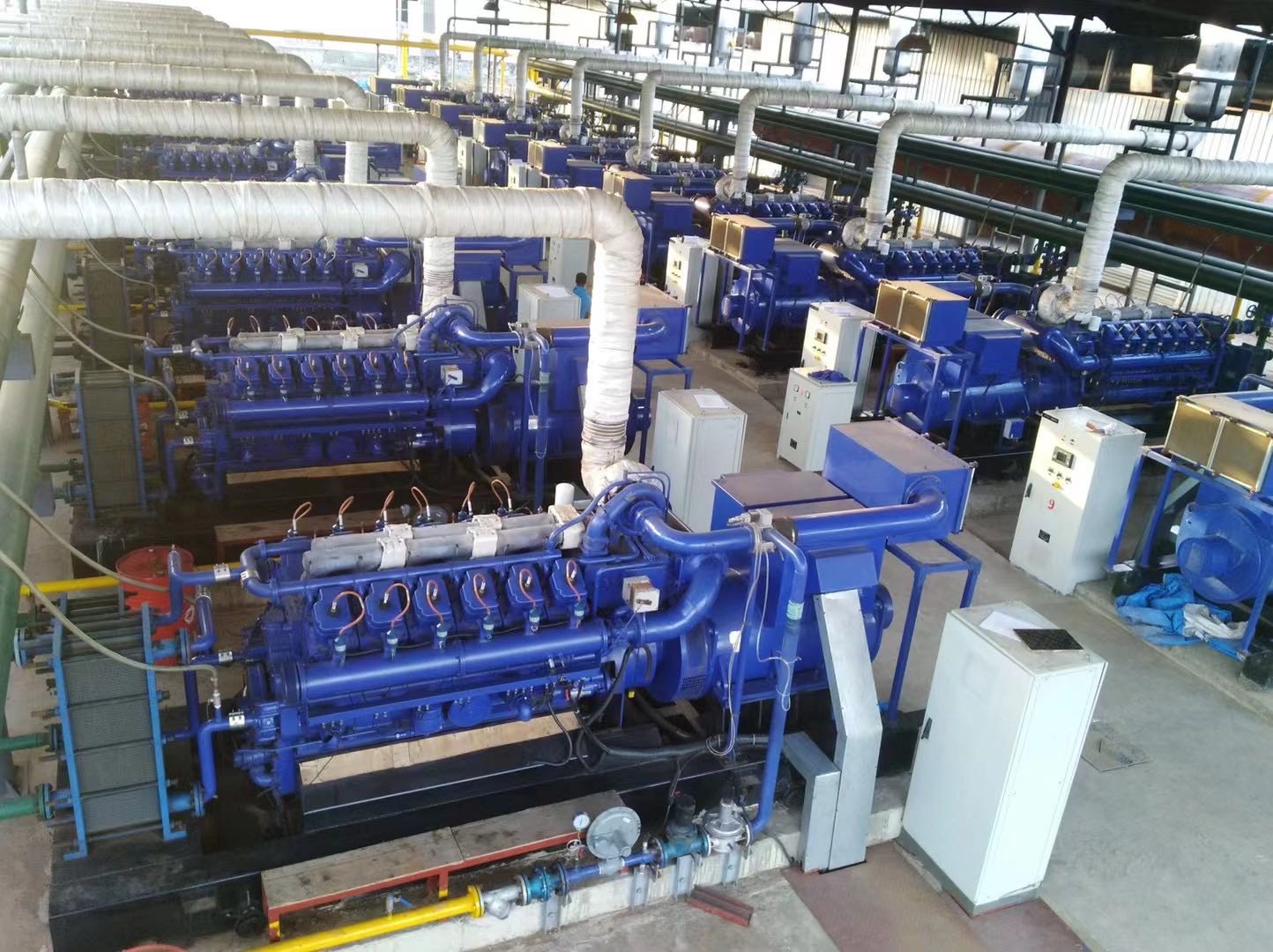 聯系 - 熱線
聯系 - 熱線
0531-69953988

 聯系 - 熱線
聯系 - 熱線
燃氣發電機組:用清潔能源點亮工業與生活
一、燃氣發電機組的核心工作原理
1、 The core working principle of gas generator set
燃氣發電機組的運行過程可以簡單理解為 “燃料燃燒驅動發電” 的循環。首先,燃料(如天然氣)通過管道進入燃氣發動機的燃燒室,與空氣混合后被火花塞點燃,產生高溫高壓氣體推動活塞往復運動,這一過程類似于汽車發動機的工作原理。活塞的運動通過曲軸傳遞給發電機的轉子,轉子在定子繞組中高速旋轉,切割磁感線從而產生電能。整個過程中,燃料的化學能依次轉化為熱能、機械能,最終變為穩定的電能輸出。
The operation process of a gas-fired generator set can be simply understood as a cycle of "fuel combustion driven power generation". Firstly, fuel (such as natural gas) enters the combustion chamber of a gas engine through a pipeline, mixes with air, and is ignited by a spark plug, producing high-temperature and high-pressure gas that drives the piston to reciprocate. This process is similar to the working principle of a car engine. The motion of the piston is transmitted to the rotor of the generator through the crankshaft, and the rotor rotates at high speed in the stator winding, cutting magnetic induction lines and generating electrical energy. Throughout the process, the chemical energy of the fuel is sequentially converted into thermal energy, mechanical energy, and ultimately into stable electrical energy output.
為了確保運行效率,燃氣發電機組通常配備進氣調節系統,通過精確控制燃料與空氣的混合比例,使燃燒更加充分;冷卻系統則通過水循環或風冷技術,防止發動機過熱;而控制系統則實時監測電壓、頻率等參數,確保輸出電力的穩定性。部分高端設備還支持余熱回收,將燃燒產生的高溫廢氣引入熱交換器,用于供暖或熱水供應,進一步提高能源利用率。
In order to ensure operational efficiency, gas generator sets are usually equipped with an intake control system, which precisely controls the mixing ratio of fuel and air to make combustion more complete; The cooling system uses water circulation or air cooling technology to prevent the engine from overheating; The control system monitors parameters such as voltage and frequency in real-time to ensure the stability of the output power. Some high-end devices also support waste heat recovery, which introduces the high-temperature exhaust gas generated by combustion into heat exchangers for heating or hot water supply, further improving energy utilization efficiency.
二、燃氣發電機組的顯著優勢
2、 Significant advantages of gas-fired generator sets
1. 清潔環保,降低污染
1. Clean and environmentally friendly, reduce pollution
與傳統柴油發電機組相比,燃氣發電機組燃燒更充分,產生的二氧化碳排放量減少約 30%,氮氧化物排放降低 50% 以上,幾乎不產生硫化物和顆粒物污染。例如,使用天然氣作為燃料時,其燃燒后的主要產物為二氧化碳和水,對環境的影響遠低于煤炭或燃油發電。這種特性使其在對環保要求較高的地區(如城市商業區、自然保護區)具有明顯優勢。
Compared with traditional diesel generator sets, gas-fired generator sets burn more fully, reducing carbon dioxide emissions by about 30% and nitrogen oxide emissions by more than 50%, and producing almost no sulfide and particulate matter pollution. For example, when using natural gas as fuel, the main products of its combustion are carbon dioxide and water, which have a much lower impact on the environment than coal or oil fired power generation. This characteristic gives it a significant advantage in areas with high environmental requirements, such as urban commercial areas and nature reserves.

2. 高效穩定,快速響應
2. Efficient, stable, and fast response
燃氣發電機組的發電效率通常在 30%-45% 之間,部分采用聯合循環技術的設備效率可超過 60%,遠超普通柴油機組的 30% 左右。此外,其啟動速度極快,從冷啟動到滿負荷運行僅需 30 秒,而柴油機組通常需要 3 分鐘以上。這種快速響應能力使其成為醫院、數據中心等對電力中斷敏感場所的理想備用電源,能夠在電網故障瞬間切換供電,避免因停電造成的設備損壞或數據丟失。
The power generation efficiency of gas-fired generator sets is usually between 30% and 45%, and some equipment using combined cycle technology can achieve an efficiency of over 60%, far exceeding the 30% efficiency of ordinary diesel generators. In addition, its starting speed is extremely fast, taking only 30 seconds from cold start to full load operation, while diesel generators usually take more than 3 minutes. This rapid response capability makes it an ideal backup power source for hospitals, data centers, and other places sensitive to power outages. It can switch power supply in the event of grid failures, avoiding equipment damage or data loss caused by power outages.
3. 燃料多樣,成本可控
3. Diverse fuels and controllable costs
燃氣發電機組不僅可以使用天然氣,還能適配沼氣、瓦斯氣、秸稈氣等多種可燃氣體。例如,在養殖場或污水處理廠,通過收集動物糞便或污水產生的沼氣作為燃料,既能降低能源成本,又能實現廢棄物的資源化利用。以沼氣發電為例,每立方米沼氣可發電 1.5-2 度,成本僅為市電的 1/3-1/2,長期運行可顯著降低企業用電成本。
Gas generator sets can not only use natural gas, but also adapt to various combustible gases such as biogas, gas, straw gas, etc. For example, in livestock farms or sewage treatment plants, collecting animal manure or biogas produced from sewage as fuel can not only reduce energy costs but also achieve the resource utilization of waste. Taking biogas power generation as an example, each cubic meter of biogas can generate 1.5-2 kWh of electricity, and the cost is only one-third to one-half of the mains electricity. Long term operation can significantly reduce the electricity cost of enterprises.
4. 低噪運行,環境友好
4. Low noise operation, environmentally friendly
燃氣發動機的機械結構相對簡單,運行時振動較小,配合消音裝置后,整體噪聲可控制在 70 分貝以下,遠低于柴油機組的 90 分貝以上。這種低噪音特性使其適用于居民區、學校等對噪聲敏感的環境。例如,在社區備用電源系統中,燃氣發電機組可以在夜間安靜運行,不會干擾居民休息。
The mechanical structure of gas engines is relatively simple, with minimal vibration during operation. When combined with noise reduction devices, the overall noise can be controlled below 70 decibels, much lower than the 90 decibels or more of diesel engines. This low noise characteristic makes it suitable for noise sensitive environments such as residential areas and schools. For example, in the community backup power system, gas generators can operate quietly at night without disturbing residents' rest.
本文由環能牌燃氣發電機組友情奉獻.更多有關的知識請點擊:http://www.newsletterv.cn我們將會對您提出的疑問進行詳細的解答,歡迎您登錄網站留言.
This article is dedicated to friendship For more information, please click: We will provide detailed answers to your questions. You are welcome to log in to our website and leave a message
業務分類
Business classification產品推薦
product recommendation聯系方式
Contact Information

截屏,微信識別二維碼